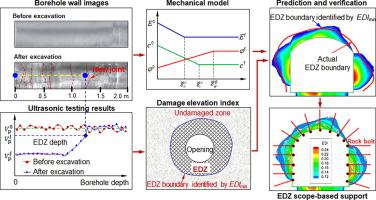Geoscience Frontiers ( IF 8.5 ) Pub Date : 2021-07-14 , DOI: 10.1016/j.gsf.2021.101273 Ding-Ping Xu 1 , Xiang Huang 1, 2 , Shao-Jun Li 1 , Huai-Sheng Xu 1, 2 , Shi-Li Qiu 1 , Hong Zheng 1 , Quan Jiang 1

|
Excavation Damaged Zone (EDZ) scope is important for optimizing excavation and support schemes in deep underground caverns. However, accurately predicting the full EDZ scope within the surrounding rock masses of deep underground caverns during excavation remains a pressing problem. This study presents a comprehensive EDZ scope prediction approach (CESPA) for the brittle surrounding rock masses of deep underground caverns by coupling numerical simulation with quantitative analysis of borehole wall images and ultrasonic test results. First, the changes in both P-velocity () and joint distribution of the surrounding rock masses before and after excavation damage are captured using ultrasonic tests and borehole digital cameras. Second, the quality Q-parameters of the surrounding rock mass before and after excavation damage are preliminarily rated with the rock mass descriptions provided by borehole wall images, and the rock mass -parameter values are determined according to the –borehole depth curves. Third, the Q-parameter ratings are further finely adjusted by updating the related Q-values to be similar with the Q-values estimated by -parameter values. Fourth, the initial and residual mechanical parameters for the rock mass deterioration model () are estimated by the adjusted Q-parameter ratings based on the modified Q-based relations, and the elastic modulus deterioration index () threshold to describe the EDZ boundary is determined with the -parameter values. Finally, EDZ scope is predicted using the elastoplastic numerical simulation with and based on the mechanical parameter estimates and threshold. Analyses of applications in Sub-lab D1 in Jinping II project show that CESPA can provide a reliable and operable solution for predicting full EDZ scopes within the brittle surrounding rock masses of deep underground caverns.
中文翻译:

结合现场测量和数值分析的综合方法预测深部地下洞穴脆性围岩内的开挖破坏区
开挖损伤区 (EDZ) 范围对于优化深部地下洞穴的开挖和支护方案非常重要。然而,在挖掘过程中准确预测深部地下洞穴围岩内的完整 EDZ 范围仍然是一个紧迫的问题。本研究通过将数值模拟与井壁图像的定量分析和超声测试结果相结合,提出了一种针对深部地下洞穴脆性围岩体的综合 EDZ 范围预测方法 (CESPA)。首先,P 速度的变化 () 和开挖破坏前后围岩体的联合分布是使用超声波测试和钻孔数码相机捕获的。二是利用钻孔壁图像提供的岩体描述对开挖破坏前后围岩质量Q参数进行初步评价- 参数值是根据 ——钻孔深度曲线。第三,通过更新相关的Q 值来进一步微调Q参数评级,使其与由-参数值。四、岩体劣化模型的初始力学参数和残余力学参数() 由基于修正Q关系的调整Q参数评级和弹性模量劣化指数 () 描述 EDZ 边界的阈值由 -参数值。最后,使用弹塑性数值模拟预测 EDZ 范围 和 基于机械参数估计和 临界点。锦屏二期项目D1分实验室的应用分析表明,CESPA可以提供可靠且可操作的解决方案,用于预测深部地下洞穴脆性围岩内的全EDZ范围。











































 京公网安备 11010802027423号
京公网安备 11010802027423号